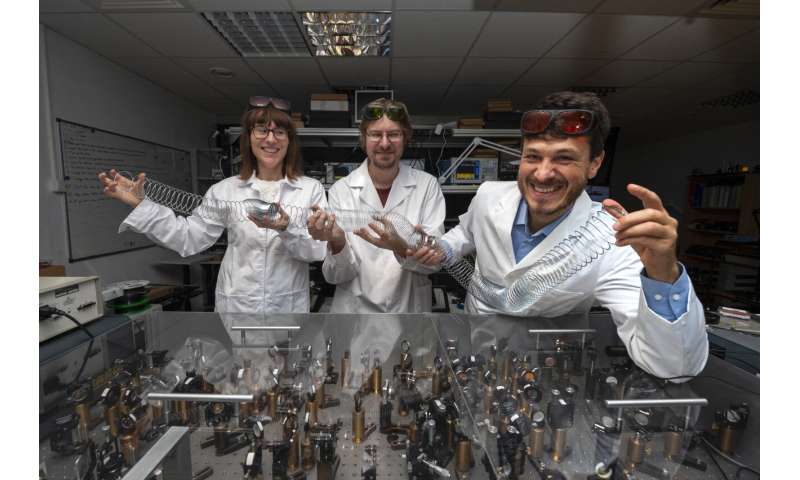From chaos to complex order

Lasers are widely used in everyday life. It can be said that laser technology boosted information processing and medicine development. However, despite their broad application, light propagation in lasers still needs detailed studies to improve fiber cavity design and understand laser physics.
Recently, Scientists from the Institute of Physical Chemistry, Polish Academy of Sciences, reported for the first time recording the double Hopf bifurcation behavior of light during the laser operation. Moreover, based on the experimental results and different mathematical models, they reconstructed the observations making it possible to predict such effects in lasers.
It has been just a few decades since the Nobel Prize was awarded for laser technology. In this time, lasers became indispensable tools we use in every area of our lives. Such devices improved the logistics for being used to read bar codes and transfer information.
What makes these devices so unique? The laser generates a beam of light through the stimulated light emission, where photons hit atoms inside the device. Emitted light goes in very short pulses lasting even picoseconds or femtoseconds. Despite the broad practical use of laser technology, it is still the subject of many studies, especially regarding the disturbance of particular signals.
As ultrafast lasers can deliver ultrahigh peak powers, the pulses can undergo sudden dynamic changes. Recently, researchers from the Institute of Physical Chemistry, Polish Academy of Sciences, led by prof. Yuriy Stepanenko presented an unusual face of lasers showing that the frequency of the particular pulse train can be modulated periodically by the additional oscillations. Researchers demonstrate the real-time experimental observation of the Hopf bifurcations of the signal during the operation of the ytterbium-doped fiber laser.
The nature of the pulses of the light during laser operation is still not fully understood, so many studies have been done in this field, particularly following the dynamics change. Regarding the bifurcations, literature referred mainly to theoretical studies with predictions of stability switches in the periodical changes. However, the experimental studies are a completely different story, and little research has been done in this area. Therefore, the results of the prof. Stepanenko group present the double Hopf bifurcation for the first time during laser operation.
They have shown that the additional oscillations can modulate the pulse dissipation periodically. It is due to the amplitude increase in response to increased pump power until reaching the stationary state. Based on the experimental results, researchers reproduced and explained the double-Hopf bifurcation within numerical simulations enabling direct, theoretical exploration of the laser medium and allowing the reproduction of their observations.
Prof. Stepanenko claims "In our work, we propose a new, more precise methodology that allows us to interpret the observed double-Hopf bifurcation-like dynamics originated from the instantaneous action of nonlinear optical loop mirror (NOLM) instead."
The numerical analyses have a background in the chaos theory that reveals the system's stability and instability or order and disorder,. It shows its complexity and describes how it evolves with time according to some patterns. The bifurcations is a switch in system's behavior that can lead to either order, or chaos. The observed double Hopf bifurcation leads certain specific and quite complex form of order where three coexisting oscillations occur.
"It is fascinating that our results can be related to the chaos theory, particularly the double-Hopf-type bifurcation dynamics phenomenon, where the additional (third) oscillation appears under the periodical frequency modulation. In our fiber laser, we observed such a double-Hopf behavior below 220 mW, which is below the pump threshold for a stable mode-locking regime".—remarks dr. Katarzyna Krupa
Dr. Tomasz M. Kardas comments—"We solved a unidirectional pulse propagation equation (UPPE) for nonlinear pulse propagation by combining different models. We found out that measured long-time oscillations are caused by the fact that highly energetic pulses are subjected to significant spectrum broadening, and, in consequence, they lose a significant amount of energy at the spectral filter located inside the cavity".
In their work, they recorded the double-Hopf bifurcation during laser operation for the first time and reproduced it by combining different models to fill the gap in the field. The results demonstrated by researchers from IPC PAS can help understand laser physics and optimization of the fiber cavity designs. Their findings may significantly contribute to cutting-edge technology by developing new "spectrum on-demand" sources. It may improve not only industrial but also biomedical laser applications.
The authors acknowledge the funding support from the Foundation of Polish Science—TEAM-NET project No. POIR.04.04.00-00-16ED/18-00.
More information:
Katarzyna Krupa et al, Real‐Time Observation of Double‐Hopf Bifurcation in an Ultrafast All‐PM Fiber Laser, Laser & Photonics Reviews (2022). DOI: 10.1002/lpor.202100646
Provided by Polish Academy of Sciences